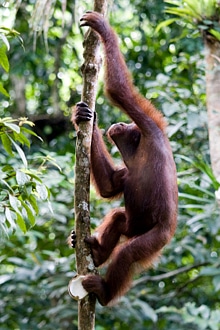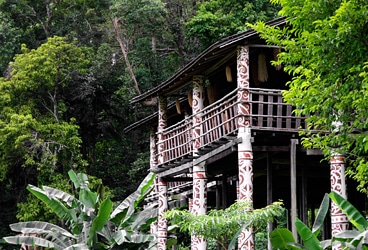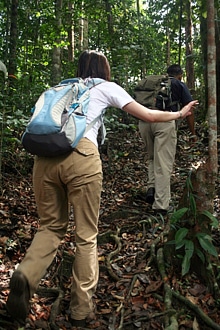Blue List: Community
What is community-based tourism? The locals themselves are the guides, showing visitors the village where they live, their daily activities and their own homes. And travelers don't just watch; they engage in the life of the village, which is usually off the beaten track, and they often spend the night in a local's home or a simple lodge. Profits go back to the community to support local projects. It's a total immersion in the culture, food, livelihood and traditions of an island. And it's unforgettable.
Borneo's Nanga Sumpa Iban Longhouse
On our fourth day, we emerge from the jungle into the sun. A woman farmer, the first person we've seen since the boatmen left our party of eight, gives us fresh sugar cane to chew on. Farther on we encounter naked children playing in the river and piglets roaming on the other side. A woman in a sarong spreads black peppercorns on a ground cloth to dry. A sprawling wooden structure with a tin roof rises on stilts behind her. This is the Nanga Sumpa Iban Longhouse, one of the traditional Iban communities in this part of Borneo that survived the flooding from the creation of the Batang Ai Reservoir in the late 1980s. Here the villagers live as their ancestors did — in a communal society that relies on the jungle to fulfill all its needs — minus the headhunting.
Later, after settling into the guest lodge, I see the three Iban men who had served as porters on our trek sitting at an outdoor table. TingKun, the oldest, is the father of four. Finally off-duty, the men wave me over to share a glass of tuak, a rice wine, with them. TingKun passes a glass of clear liquid to me, and I offer them a salute before sipping the home-made hooch. They patiently wait for me to realize that I am holding the only glass. This is the most intimate interaction we've shared thus far.
Though tentative, TingKun speaks directly to me for the first time as he draws a rough map in my notebook so I can piece together where we've been. Borneo Adventure has brought visitors to Nanga Sumpa since 1987. Though I started with the trek to look for orangutans, most people come directly here for the promise of cultural immersion. The community shares the work and its bounty. The Nanga Sumpa families offer boat transportation and porters to assist treks like ours, as well as providing the hospitality, the crafts for sale, and the spices and other food culled from sustenance farm plots. The revenue from the tours and the sale of goods helps communities sustain their traditional culture. Visitors get the rare opportunity to enter that culture, even participate in it, deep in the forest where it evolved. But first they have to get there — the easy way or the, er, scenic route.
I did the latter. To reach the longhouse, we had departed from Kuching, the small, bustling capital of the state of Sarawak in Malaysian Borneo, traveling five hours by van to the Batang Ai Reservoir near the Indonesian border. That's where we'd first met Bayang and I had asked him if he was our guide. "I am going with you," he'd told me in English. "For the next few days there are no guides, no guests. We are all just friends." I appreciated the sentiment, but I wondered why I didn't simply take the much quicker boat ride across the reservoir rather than meandering through the wilderness.
We piled into carved longboats and traveled the river system until the boats ran aground. I stood on the dry riverbed as the porters unloaded the gear and then watched the boatmen pull away. Now I was entirely dependent on these strangers. Dressed in T-shirts, shorts and rubber sandals and carrying machetes, TingKun and "friends" shouldered woven rattan backpacks, each loaded with nearly 100 pounds of camping equipment, and then took off. Bayang led us visitors at a much slower pace.
For four days I was pushed to my limits. We rappelled down steep riverbanks using gnarly vines as ropes. Felled logs served as bridges over ravines. "This one was cut down 200 years ago by one man with just a knife and ax, to prove his strength," Bayang said, crossing one.

There were blind tiger leeches in pursuit of soft, warm flesh and steep, slippery trails where I often lost my footing. My lungs and thighs ached as we climbed up, up and out of the baroque jungle cathedral into the sparse forest church where virgin hardwood trees soared upward of two hundred feet. This is where orangutans build nests. We saw plenty of strange creatures as the days unfolded, but the orangutans remained elusive.
Still, I didn't mind. The porters cared for us well. They cooked our meals — usually rice and vegetables stuffed inside bamboo, steamed over a fire and served on banana leaves — foraged for sticks and vines to complete the setup at camp, and hauled and boiled our drinking water. They mostly kept to themselves, though Bayang told us they really enjoy this work. "They like being with you," he'd said, and the income allows them to continue living in their remote villages.
In time, I felt an internal shift and began to accept the gifts offered by the jungle. There were waterfalls under which to swim and respites with hot sugary tea brewed over a fire and drunk from hollow bamboo cups. The chainsaw symphony of the cicadas lulled us to sleep, and barking deer woke us. Camaraderie developed between the guests and the guides. Just as Bayang had predicted, out there we were all just human beings, offering anything we could — survival skills, cultural exchange, an extended hand up a slippery slope, a smile.
By the time we reached our guest lodge adjacent to Nanga Sumpa, I was exhausted and looking forward to a shower (albeit cold) and an afternoon of relaxation. Borneo Adventure built the lodge in 1999 to facilitate visits without displacing families in the longhouse. Each guest has a doorless room off a corridor surrounding a courtyard, and we share a bathroom (much like one found at a gym).
The afternoon storm arrives like clockwork, and I wait it out in the covered dining area that overlooks the river. As I scan the entries in the guest book and see names from nations too numerous to mention, I feel as though I've joined a club. I realized our combined visits do make a difference — not just the financial impact on this community, but the leap in our understanding of the Iban people and of this magical place that they call home, deep within the island of Borneo.
At dusk, we climb the steep plank, carved much like a totem, to the entrance of the longhouse. Inside, a wide corridor stretches what seems like the length of a football field. Rattan mats cover the floor. The stuff of life — cloth- ing, crafts, musical instruments, netting — hangs from every timber. "Twenty-two families live here," Bayang says, "and nine more in the adjacent compounds."
Chief Ngumbang, wearing a T-shirt and shorts, welcomes us. We sit in a circle on the mats, and an elderly woman with tattoos up and down her arms brings the chief six glasses and a bottle of tuak. Bayang explains that the tattoos describe her wifely skill at curing the heads her warrior husband once brought home. As the chief metes out the wine, Bayang tells us the woman is also renowned for the intricacy of her weavings. "The designs come to her in dreams," he says.
Loosened by tuak, we ask questions, with Bayang translating. Sumpa, the name of this longhouse, was chosen in the spirit of reconciliation after a history of quarreling among tribes. The elected chief, who must know how to read and write, meets with government officials and represents his people. When he pours another round of the potent tonic, I drink a little and then get up to browse the crafts set out on mats by their makers.

I buy aromatic peppercorns in recycled soda bottles and a woven, cylindrical red-and-yellow basket with legs that I'll take home to store our remote controls.
On our last morning, we return to the longhouse for a more casual visit. Bayang introduces us to his "adopted" Nanga Sumpa family. They invite us in to see their private quarters, a single room where they keep their be- longings, cook their food and sleep. In the main corridor, men and women sit in patches of sunlight, weaving and carving. I'm still an outsider, still dependent on my hosts, but I no longer feel stranded. How- ever briefly, I have joined this community and played a small part in its survival. I feel welcome here.
The boatmen arrive to take us on the first leg of our journey back to Kuching. When the longboats emerge from the river into the wide-open Batang Ai Reservoir — just five hours from hot showers and ice-cold Bintang beer — I almost shout out, "Turn around!" I want to stay longer. borneoadventure.com
Community: More Winners In addition to our featured trip detailed above, ISLANDS recommends these trips from our 2009 Blue List, which also represent the best in sustainable travel.
Rosalie Forest Eco-Lodge's Community Life Package, DominicaIf the beauty of community-based tourism is an abundance of options, this seven-day itinerary is especially lovely. Learn about herbal remedies on an organic farm in the morning; help teach primary-school children in the afternoon. You can also roast your own coffee, make crafts from coconuts you just harvested, and even practice with a reggae band. rosalieforest.com
Koh Yao Noi Eco-Tourism Club, ThailandWhen this island in Thailand's Phangnga Bay was earning a higher profile from tourists — and commercial fishermen — the local villagers had the foresight to create this club. Now proceeds from travelers go into a community fund to protect the culture, and traditional-style fishing trips focus international attention on protecting the natural resources here. responsibletravel.com
Countrystyle Community Experience, JamaicaThe seven-day tour package has three community experiences: Roots Jamaica, in which a rural village welcomes you as one of its own; Taste of Jamaica, an eating tour of the countryside, ranging from ackee to bammy to ortaniques; and Jamaica Naturally, a packed itinerary of villages and waterfalls, mountains, rivers and 25 of Jamaica's endemic bird species. countrystylejamaica.com
Actuar's Rural Escape, Chira Island What makes this tour to one of Costa Rica's most enticing islands is that its centerpiece is Chira's dynamic women. To benefit their community, they run an association that leads eco-education walks, cooks by solar energy, manages the mangrove forest and more. This two-day trip explores all of that — plus birdwatching and beaches. actuarcostarica.com
JED Trip, Ceningan IslandLearn exactly how versatile seaweed is when you bite into your own freshly made seaweed cake. That's just one of the unusual delights after a day canoeing with farmers across their seaweed plantations on this island off Bali's east coast. The locals have protected their island from tourist development, yet they embrace the customized visits here. Your memories will be anything but typical. jed.or.id
